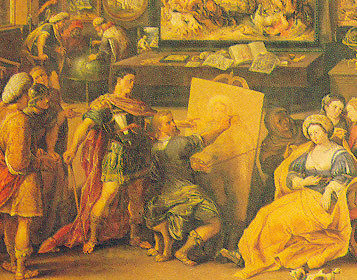Publicado pela primeira vez em 1936, o livro The Materials and Techniques of Medieval Painting, de Daniel V. Thompson, continua a ser uma obra de referência sobre os materiais e as técnicas da pintura medieval. Não obstante alguma inevitável desactualização, constitui a única visão de conjunto sobre esse tema e continua a ser de consulta obrigatória. Essa mesma razão explica que o livro tenha conhecido múltiplas reedições por parte da Dover Publications, a partir de 1956, e que ainda hoje continue à venda.
Esta é uma das obras mais conhecidas de Daniel V. Thompson. A outra é a tradução que em 1933 publicou do Il Libro dell’Arte, de Cennino Cennini, de cerca de 1390, que constitui a edição de referência em língua inglesa desse tratado que tanta informação proporciona sobre a os materiais e as técnicas da pintura medieval praticada em Itália. Uma outra obra sua que também teve uma divulgação significativa, ainda que menor do que as duas anteriores, é o livro The Practice of Tempera Painting, de 1936. Qualquer um dos volumes está disponível no catálogo da Dover Publications.
The Materials and Techniques of Medieval Painting está disponível livremente na internet em duas edições. A primeira edição, de 1936, está aqui. A primeira edição da Dover Publications, de 1956, está aqui.
Prefácio:
This volume is designed for those who care for what my dearest enemy calls “the cookery of art,” for those who wonder about the natures and the sources of the materials out of which painters in the Middle Ages compounded objects that we still cherish. I have developed elsewhere the thesis that style and technique are inseparable, and this enquiry into cookery, this sojourn in the kitchen, would be unwarranted if it did not lead to some slightly more keen or intelligent appreciation of the finished dishes. “‘Style and technique are inseparable,’” writes my learned friend M. Henri Focillon: “Voilá la vérité, que méconnaissent seuls ceux oui travaillent du dehors.”
The functions of technique in the development of styles of architecture have long been recognized. The technical bases of design and ornament in pottery, glass, textiles, and metalwork are regularly seen in something like their true perspective. The late Dr. Josef Meder of Vienna brought great judgment and penetradon to the unit study of technique and style in drawing; and the considerations of material and manipulation which affected the evolution of style in early woodcuts have been set forth brilliantly and estimated sagaciously by Mr. Arthur Hind of the British Museum within the last few months. It is not possible as yet to see the relationships of style and technique in medieval painting with such clarity; for the technical elements are more complicated and more obscure. This little book can by no means make them clear; but it may answer some of the questions which acquaintance with medieval paintings always raises. I hope that the answers will be found free both from pedantry and from romantic surmise.
Postponing the great issues of technical manipulation, I have discussed here only the materials of painting in medieval Europe. I have tried to assess the present state of our knowledge, and to incorporate some measure of new understanding drawn from a study of many unpublished medieval documents, as well as to review the content of such medieval writings on art-technology as have been edited. This literary evidence has been examined wherever possible in the light of experimental and analytical evidence. By far the largest and most orderly body of analytical observation of medieval painting materials so far available has been presented by Dr. A. P. Laurie, whose studies in the physical nature of medieval paintings provide invaluable assistance in the interpretation and estimation of the documents. A large part of this book is based upon a course of lectures, "Technique in Medieval Art," given in the autumn of 1935 at the Courtauld Institute of Art in the University of London, and I owe to that Institute's Director, Professor W. G. Constable, both the incentive to formulate this study and encouragement to publish it.
Índice:
- Introduction
- Carriers and grounds
- Binding media
- Pigments
- Metals

























